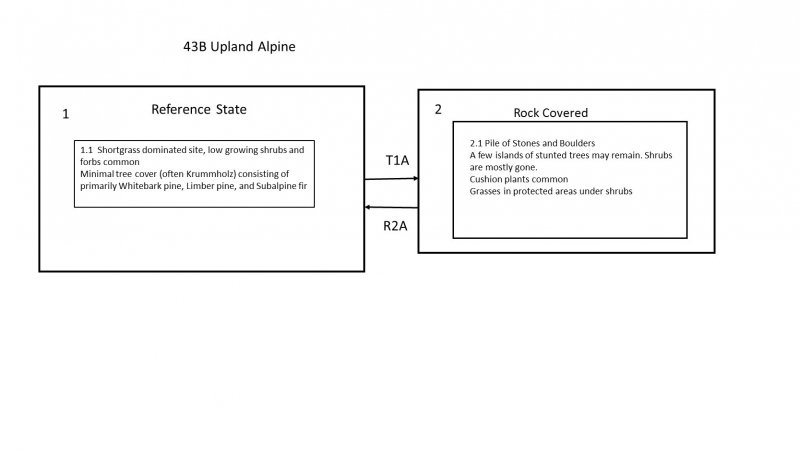
Natural Resources
Conservation Service
Ecological site R043BP821MT
Upland Alpine Group
Last updated: 3/01/2024
Accessed: 12/08/2025
General information
Provisional. A provisional ecological site description has undergone quality control and quality assurance review. It contains a working state and transition model and enough information to identify the ecological site.
MLRA notes
Major Land Resource Area (MLRA): 043B–Central Rocky Mountains
The Central Rocky Mountains (MLRA 43B) of Montana occupy some 28,850 square miles and exist primarily in Central and SW portions of the state. The climate is extremely variable with precipitation lows of 9 to 100 inches per year and frost free days of less than 30 to over 110 days. The geology of the region is also highly variable. The combination of variable climate and geology create a complex relationship of plant communities. MLRA 43B elevations typically exist between 6000 and 12,799ft at Granite Peak (the highest point in Montana).
The Continental Divide runs through this MLRA effectively splitting its watershed to contribute to either the Missouri River to the East and the Columbia River to the West.
Ecological site concept
• Site does not receive any additional water
• Soils are
o Generally not saline or saline-sodic (limited extent)
o Moderately deep, deep, or very deep
o Strongly or violently effervescent within surface mineral 4”
o Soil is not ashy or medial textural family
o Stones and boulders cover less than 15% surface area or fragmental textural class
• Moisture Regime: Udic
• Temperature Regime: Cryic
• Dominant Cover: Non-forested land (typically associated with krummholz vegetation)
• Elevation Range: 5000-10000ft
• Slope Range: 0-70%
Site Development and Testing Plan
This Provisional Ecological Site Description was developed to meet the criteria as defined in Soil Survey National Instruction part 306 (430-306-NI, April 2015) as interpreted by Regional Ecological Site Specialist. Information in this description are first approximations based on broad groupings of soil properties and vegetation characteristics associated with those groupings. Although this description has been through the quality control and quality assurance review process it has not been certified for use in conservation planning.
Associated sites
| R043BP823MT |
Shallow Alpine Group The Shallow Alpine is a neighboring site that exists higher on the landscape. The Shallow Alpine and the Upland Alpine share similar plant communities and state and transition models however, the Upland Alpine Site will produce higher amounts annual production. |
|---|
Similar sites
| R043BP823MT |
Shallow Alpine Group The Shallow Alpine is a neighboring site that exists higher on the landscape. The Shallow Alpine and the Upland Alpine share similar plant communities and state and transition models however, the Upland Alpine Site will produce higher amounts annual production. |
|---|
Table 1. Dominant plant species
| Tree |
(1) Pinus albicaulis |
|---|---|
| Shrub |
(1) Vaccinium scoparium |
| Herbaceous |
(1) Poa alpina |
Click on box and path labels to scroll to the respective text.

